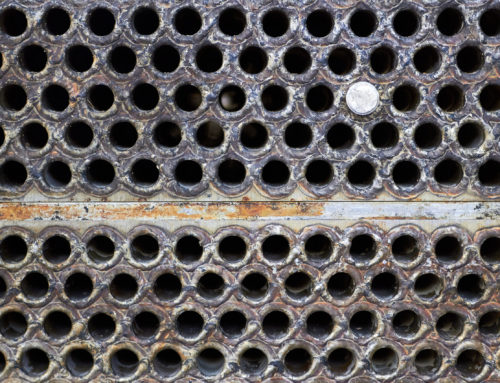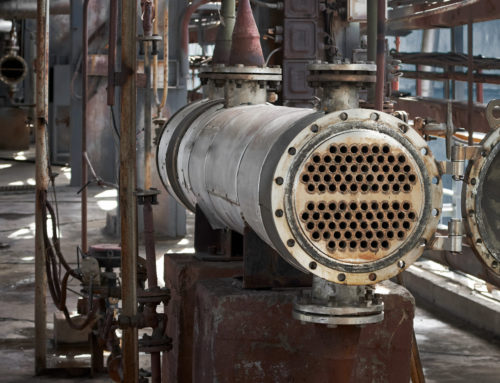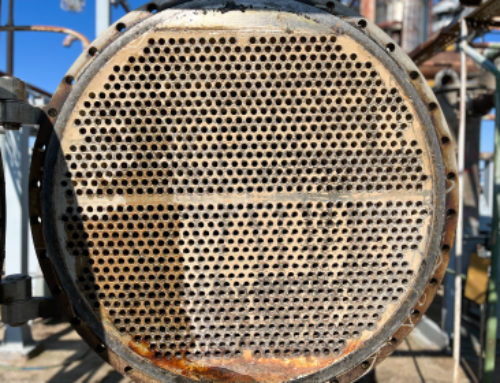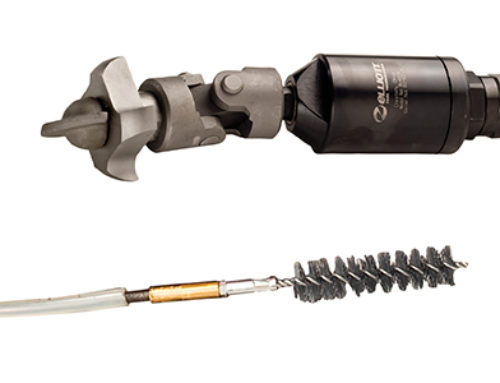Select The Right Cleaning Head For The Job
Cleaning tubes increases energy efficiency. Every tubed vessel (ex: boilers, heat exchangers, condensers, chillers, etc.) requires the surface of the tubes to be clean and scale-free to function efficiently. If deposits or scale are present, the flow through the vessel and the efficiency of the vessel decreases. The entire system must compensate and will require increased pump horse powers, increased flows of fuel, etc. to overcome the decreased energy production. In addition to efficiency loss, some deposits are corrosive in nature and will eventually cause damage to the tube walls.

Deposits and scale (silicates, sulphates, sulphites, carbonates, calcium, organic growths, etc.) all have the potential to cause tube wall damage and/or decrease efficiency.
In order to properly maintain heat exchangers and boilers, the right cleaning tools must be selected to clean tubes. Choosing the correct cleaning tool depends on many different factors:
- Tube dimensions
- Tube material
- Tube u-bend or curve
- Deposit type
- Thickness of the deposit
- Evenness of the deposit
- And others
Additionally, there are several styles of cleaning tools and heads ranging from brushes to drills to cutters. All of these variables increase the difficulty of cleaning tool selection. No two companies have the same type and thickness of deposits to remove and even the same company will seldom have two tube cleaning sessions that are exactly the same. Therefore, each tube cleaning job should be considered and treated as individuals with its own solution.
Two of the most common reasons for tube cleaning tool failure is incorrect application and no universal cleaning head available for all applications. This makes it very important to communicate details about the job to find the right head. As a general rule, drills are most often used for cleaning of hard powder, hard deposit and rock solid deposits and sometimes scale or soft deposits of medium or heavy thickness. For lighter deposits or for more organic, soft deposits, other cleaning tools (i.e. brushes or scrubber brushes) would be more economical and efficient.
Depending on what type of vessel and what type of deposit, know your vessels and equipment and consider the responses to these questions before making a cleaning head selection:
What is the tube size? Is the tube average wall or minimum wall?
Tube size is key in selecting the properly sized head for the job. Selecting a head that is too small will not properly clean the vessel. Brushes that are too small will not touch the tube ID to clean it and more aggressive cleaning heads that are too small can actually severely damage or puncture the tube by bouncing around in the tube. Selecting a head that is too large increases the risk of tube damage and may also become stuck inside of the vessel. Know and understand if your tubing is minimum wall or average wall before selecting cleaning heads.
What is the tube length?
The longer the tube, the longer the cleaning shaft required and the more power needed if using shoot-thru brushes or scrubbers. In many cases, it is recommended to use a cleaning shaft about half the length of the tube and clean from both tube sheet sides. This will allow for a shorter shaft or cable, which is easier to manage and less prone to breakage or damage.
What is the tube material?
A softer tube material may require a less aggressive cleaning head in order to decrease the risk of tube damage. A harder tube material can withstand more aggressive cleaning.
Is there any bend or curve to the tubing? If so, what is the minimum radius?
A curved tube will require a motor and cleaning head able to be used with a curved tube. Be sure to know the minimum radius of the curve to ensure that the cleaning motor has adequate clearance to maneuver within the tube without becoming stuck. In extreme cases where the tube it completely blocked, a different, more aggressive cleaning methods may be required.
Is the tubing enhanced (rifling or micro-deformation)?
If the tube is enhanced, certain cleaning methods may destroy the enhancements and will result in a loss of the efficiency. With micro-deformation tubes, brushes are most often used with a water flush and an actuator that pulses the brush linearly. This is the only method of cleaning designed specifically for micro-deformation tubes. Also, the size of the brush is also important – using a brush too large may damage some of the enhancement, but alternatively, using a brush that is too small will not clean the tubes properly.
What is the type of deposit? What is the vessel being used for?
Review the deposit within the tubes. There are several generic types of deposit. Most common deposits can be classified in one of the following groups:
- Soft, organic deposits
- Gummy deposits
- Hard powder deposits
- Rock solid deposits
How thick is the deposit? Is the deposit evenly distributed?
The thickness of a deposit is relative to the person looking at it, which can make the thickness difficult to judge. The thickness of deposit around the end of the tube may be different than further inside the tube. There may also be blockages that are not easily seen. All of these are things to consider when picking a cleaning head. Sometimes a thick, hard deposit may require a dual sweep – cleaning once with a more aggressive head to break up the deposit and then going over it again with a second cleaning head to remove the remaining deposit.





